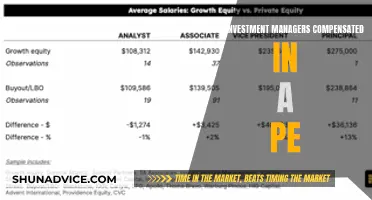
When it comes to investing, there are many options to consider, each with its own level of risk and potential return. While some investments offer the potential for high returns, they also come with a higher risk of loss. On the other hand, safe investment options prioritize capital preservation and stable, predictable income over high returns. The percentage of a portfolio that should be allocated to safe investments depends on individual financial circumstances, goals, and risk tolerance. Generally, financial experts recommend allocating around 10% to 20% of a portfolio to safe investments.
| Characteristics | Values |
|---|---|
| Percentage of portfolio to be allocated to safe investments | 10% to 20% |
| Safe investment options | U.S. Treasury securities, money market mutual funds, high-yield savings accounts, cash, government bonds, corporate bonds, dividend stocks, preferred shares, CDs, cash management accounts, green bonds, municipal bonds, Treasury Inflation-Protected Securities (TIPS) |
| Risk | Minimal risk of loss, but not entirely risk-free |
| Returns | Modest returns, not high returns |
| Liquidity | High liquidity |
What You'll Learn

US Treasury securities
Treasury securities are available in various forms, including Treasury bills, notes, bonds, and Treasury Inflation-Protected Securities (TIPS). Treasury bills typically mature in one year or less, while notes can stretch up to 10 years, and bonds usually mature in 20 or 30 years. TIPS are designed to protect investors' money from inflation by adjusting the principal value based on the current rate of CPI inflation, ensuring that the investor's purchasing power remains intact.
While US Treasury securities are considered safe, it's important to remember that no investment is entirely risk-free. They are subject to market risks and can be influenced by factors such as monetary policy, economic growth, and inflation. However, their low risk of default and stable returns make them a popular choice for investors seeking capital preservation and a diversified portfolio.
Should You Invest in NFOs?
You may want to see also

Money market funds
Government money market funds are considered the safest and most liquid type of money market fund. This is because they invest only in assets backed by the federal government, such as Treasury bonds. At least 99.5% of their assets are backed by the full faith and credit of the U.S. government. Retail funds, on the other hand, invest in other types of assets, such as municipal bonds or short-term, high-quality corporate bonds.
REITs: A Safe Investment Bet or Risky Business?
You may want to see also

High-yield savings accounts
While there is no such thing as a completely risk-free investment, high-yield savings accounts are considered one of the safest investment options available. They are a good option for those who prioritise capital preservation and stable, predictable income over high returns. These accounts offer a low-risk option with higher interest rates than regular savings accounts.
The Annual Percentage Yield (APY) of these accounts varies and is subject to change at any time without notice. As of March 2025, the highest savings account interest rates were up to 5% APY.
To find the best rates, it is recommended to search online and compare what different banks offer. Some accounts may also offer additional benefits, such as automatic sweeps that move unused cash into a high-yield money market fund.
Overall, high-yield savings accounts are a safe and stable investment option that can provide a modest return on your money while also allowing easy access to your funds.
Who's the Shark Tank India's Top Investor Shark?
You may want to see also

Government bonds
While there are no risk-free investments, government bonds are often considered among the safest investment options available. This is because there is minimal risk of loss. Government bonds are a type of US government debt security, and T-bonds offer a safe and stable investment for a diversified portfolio.
Treasury Inflation-Protected Securities (TIPS) are government bonds that protect your money from inflation. With TIPS, the value of your principal rises or falls over the term of the security, depending on the current rate of CPI inflation. The interest rate on each security is fixed, but since the principal fluctuates in value, your interest payments also rise and fall. At maturity, if the principal is higher than your original investment, you keep the increased amount. If the principal is equal to or lower than your principal investment, you get the original amount back. TIPS pay interest every six months, based on the adjusted principal.
Treasury securities are also considered highly liquid, as there is always a market for US government-backed securities. The maturity date of the Treasuries you invest in will determine how liquid (easily sellable) your investment will be. Typically, Treasury bills, which have maturities of a year or less, will be the most liquid option, while 30-year bonds will give you the least liquidity.
While government bonds are generally considered safer than stocks, they are considered riskier than cash and savings accounts. Corporate bonds are somewhat riskier than government bonds but usually pay higher interest. If a corporation goes bankrupt, bondholders are paid their money before stockholders.
As a general rule of thumb, financial experts suggest allocating around 10% to 20% of your portfolio to safe investments.
Unlocking Private Equity: Barriers to Entry and Access
You may want to see also

Corporate bonds
One of the advantages of corporate bonds is that they provide a diversified investment portfolio, especially for investors with a stock-heavy portfolio. Investing in bond exchange-traded funds (ETFs) or mutual funds allows investors to access a broad group of bonds and build a diversified portfolio, even with smaller amounts of money. Bond ETFs also provide better pricing and higher liquidity compared to individual bond issues.
However, it is important to note that corporate bonds have higher default rates than government or municipal bonds. While they offer higher interest yields, there is a risk of losing money if the bonds are sold before maturity. The value of corporate bonds is influenced by interest rates, with bond prices falling when interest rates rise. Therefore, investors seeking higher returns may consider investing in stocks, which offer greater potential for growth but also carry more risk.
When considering corporate bonds as a safe investment option, it is essential to assess your financial goals, risk tolerance, and time horizon. While corporate bonds offer lower risk compared to stocks, they may not provide the same level of stability as other low-risk investment options like government bonds, high-yield savings accounts, or money market funds. Diversifying your investment portfolio across different asset classes can help mitigate risks and provide a balance between safe and higher-return investments.
Finance and Investment Management: Strategies for Success
You may want to see also
Frequently asked questions
Safe investment options include high-yield savings accounts, money market funds, certificates of deposit (CDs), corporate bonds, dividend stocks, and preferred shares. Treasury securities, cash, and government bonds are also considered safe investments.
Safe investments provide stability and diversification to your portfolio. They are a good option if you want to preserve your principal and have good liquidity.
The percentage of your portfolio that should be allocated to safe investments depends on your individual financial situation, investment goals, and risk tolerance. As a general guideline, financial experts suggest allocating around 10% to 20% of your portfolio to safe investments.
While safe investments are designed to protect your capital, it's important to remember that no investment is entirely risk-free. Inflation can erode the purchasing power of your money over time, even in low-risk investments like cash and government bonds.
Safe investments typically offer modest returns compared to riskier assets. However, some options, such as high-yield savings accounts and dividend stocks, can provide higher interest rates or dividends while still being considered relatively safe.







